Awesome, you're subscribed!
Thanks for subscribing! Look out for your first newsletter in your inbox soon!
The best things in life are free.
Sign up for our email to enjoy your city without spending a thing (as well as some options when you’re feeling flush).
Déjà vu! We already have this email. Try another?
By entering your email address you agree to our Terms of Use and Privacy Policy and consent to receive emails from Time Out about news, events, offers and partner promotions.
- Things to Do
- Food & Drink
- Arts & Culture
- Time Out Market
- Coca-Cola Foodmarks
- Los Angeles
Get us in your inbox
🙌 Awesome, you're subscribed!


Here’s every country Queen Elizabeth II visited in her 70-year reign
From Algeria to Zimbabwe, the Queen visited at least 117 different countries

Queen Elizabeth II, who died earlier today , was probably the best-travelled monarch in history. In her 70 years as UK monarch, Her Maj apparently travelled to at least 117 different countries – and covered over a million miles, according to The Telegraph .
The Queen travelled for loads of reasons, from ceremonial openings to official state visits, but she got around so much primarily because she was head of state for the Commonwealth: a political association of countries that were largely conquered by Britain back when it was an imperial power. RECOMMENDED: How the world is paying tribute to Queen Elizabeth II
In fact, Elizabeth II wasn’t just the Queen of the United Kingdom: during her time on the throne, she reigned over a total of 32 sovereign countries. Having started her reign in the final years of the British Empire, she ruled over a number of former British colonies as they became independent sovereign states. Many, but not all, later cut ties with the monarchy and became republics.
Queen Elizabeth II reigned, at various points, over Antigua and Barbuda, Australia, the Bahamas, Barbados, Belize, Canada, Ceylon (later Sri Lanka), Fiji, Gambia, Ghana, Grenada, Guyana, Jamaica, Kenya, Malawi, Malta, Mauritius, New Zealand, Nigeria, Pakistan, Papua New Guinea, Saint Kitts and Nevis, Saint Lucia, St Vincent and the Grenadines, Sierra Leone, the Solomon Islands, South Africa, Tanganyika (later Tanzania), Trinidad and Tobago, Tuvalu, Uganda and, of course, the UK . She was also proclaimed as queen by Rhodesia, the predecessor to Zimbabwe.
By the time of her death, she was still the queen of 15 countries: Antigua and Barbuda, Australia, the Bahamas, Belize, Canada, Grenada, Jamaica, New Zealand, Papua New Guinea, Saint Kitts and Nevis, Saint Lucia, Saint Vincent and the Grenadines, the Solomon Islands, Tuvalu and the UK. She was the Queen of Barbados until November 2021, when the Caribbean nation became a republic.
As you’d expect, the Queen visited all of these places – and plenty more – during her 70-year reign. Here is a full list of all the countries and states the Queen travelled to during her reign, and the dates when she visited.
Algeria (1980)
Antigua and Barbuda (1966, 1977, 1985)
Australia (1953, 1963, 1970, 1973, 1974, 1977, 1980, 1981, 1982, 1986, 1988, 1992, 2000, 2002, 2011)
Austria (1969)
Bahamas (1966, 1977, 1985, 1994)
Bahrain (1979)
Bangladesh (1983)
Barbados (1966, 1977, 1985, 1989)
Belgium (1966, 1993, 1998, 2007)
Belize (1985, 1994)
Bermuda (1953, 1975, 1983, 1994, 2009)
Botswana (1979)
Brazil (1968)
British Virgin Islands (1966, 1977)
Brunei (1998)
Canada (1957, 1959, 1963, 1966, 1967, 1970, 1971, 1973, 1974, 1976, 1977, 1978, 1982, 1983, 1987, 1990, 1992, 1994, 1997, 2002, 2005, 2010)
Cayman Islands (1983, 1994)
Chile (1968)
China (1986)
Cook Islands (1974)
Cyprus (1961, 1983, 1984, 1993)
Czech Republic (1996)
Denmark (1957, 1979)
Dominica (1966, 1985, 1994)
Estonia (2006)
Ethiopia (1965)
Fiji (1953, 1963, 1970, 1973, 1977, 1982)
Finland (1976, 1994)
France (1957, 1972, 1992, 1994, 2004, 2014)
Gambia (1961)
Germany (1990, 1992, 2004, 2015)
Ghana (1961, 1999)
Grenada (1966, 1985)
Guyana (1966, 1994)
Hungary (1993)
Iceland (1990)
India (1961, 1983, 1997)
Indonesia (1974)
Iran (1961)
Ireland (2011)
Italy (1961, 1980, 2000, 2014)
Jamaica (1953, 1966, 1975, 1983, 1994, 2002)
Japan (1975)
Jordan (1984)
Kenya (1952, 1972, 1983, 1991)
Kiribati (1982)
Kuwait (1979)
Latvia (2006)
Liberia (1961)
Libya (1954)
Lithuania (2006)
Luxembourg (1976)
Malawi (1979)
Malaysia (1972, 1989, 1998)
Maldives (1972)
Malta (1954, 1967, 1992, 2005, 2015)
Mauritius (1972)
Mexico (1975, 1983)
Morocco (1980)
Mozambique (1999)
Namibia (1991)
Nauru (1982)
Nepal (1961, 1986)
Netherlands (1958, 1988, 2007)
New Zealand (1953, 1963, 1970, 1974, 1977, 1981, 1986, 1990, 1995, 2002)
Nigeria (1956, 2003)
Norway (1955, 1981, 2001)
Oman (1979, 2010)
Pakistan (1961, 1997)
Panama (1953)
Papua New Guinea (1974, 1977, 1982)
Poland (1996)
Portugal (1957, 1985)
Qatar (1979)
Russia (1994)
Saint Kitts and Nevis (1985)
Saint Lucia (1966, 1985)
Saint Vincent and the Grenadines (1966, 1985)
Samoa (1977)
Saudi Arabia (1979)
Seychelles (1972)
Sierra Leone (1961)
Singapore (1972, 1989)
Solomon Islands (1982)
South Africa (1995, 1999)
South Korea (1999)
Slovakia (2008)
Slovenia (2008)
Spain (1988)
Sri Lanka (1954, 1981)
Sudan (1965)
Sweden (1956, 1983)
Switzerland (1980)
Tanzania (1979)
Thailand (1972, 1996)
Tonga (1953, 1970, 1977)
Trinidad & Tobago (1966, 1985, 2009)
Tunisia (1980)
Turkey (1971, 2008)
Turks and Caicos Islands (1966)
Tuvalu (1982)
Uganda (1954, 2007)
UAE (1979, 2010)
USA (1957, 1976, 1983, 1991, 2007)
Vatican City (1961, 1980, 2000, 2014)
West Germany (1965, 1978, 1987)
Yugoslavia (1972)
Zambia (1979)
Zimbabwe (1991)
What will happen now that the Queen has died?
Will there be a UK bank holiday to mark the death of the Queen?
Everything you need to know about the Queen’s funeral
A military procession for the Queen is planned next week in London
Unusual things that will happen in London after the Queen’s death
- Ed Cunningham News Editor, Time Out UK and Time Out London
Share the story
An email you’ll actually love
More on the Queen
Discover Time Out original video
- Press office
- Investor relations
- Work for Time Out
- Editorial guidelines
- Privacy notice
- Do not sell my information
- Cookie policy
- Accessibility statement
- Terms of use
- Modern slavery statement
- Manage cookies
- Advertising
Time Out Worldwide
- All Time Out Locations
- North America
- South America
- South Pacific
Stay up to date with notifications from The Independent
Notifications can be managed in browser preferences.
UK Edition Change
- UK Politics
- News Videos
- Paris 2024 Olympics
- Rugby Union
- Sport Videos
- John Rentoul
- Mary Dejevsky
- Andrew Grice
- Sean O’Grady
- Photography
- Theatre & Dance
- Culture Videos
- Food & Drink
- Health & Families
- Royal Family
- Electric Vehicles
- Lifestyle Videos
- UK Hotel Reviews
- News & Advice
- Simon Calder
- Australia & New Zealand
South America
- C. America & Caribbean
Middle East
- Politics Explained
- News Analysis
- Today’s Edition
- Home & Garden
- Fashion & Beauty
- Travel & Outdoors
- Sports & Fitness
- Sustainable Living
- Climate Videos
- Behind The Headlines
- On The Ground
- Decomplicated
- You Ask The Questions
- Binge Watch
- Travel Smart
- Watch on your TV
- Crosswords & Puzzles
- Most Commented
- Newsletters
- Ask Me Anything
- Virtual Events
- Betting Sites
- Online Casinos
- Wine Offers
Thank you for registering
Please refresh the page or navigate to another page on the site to be automatically logged in Please refresh your browser to be logged in
Queen Elizabeth II: Which countries did the world’s most-travelled monarch visit the most during her reign?
During her long reign, her majesty made almost 300 state visits around the world, article bookmarked.
Find your bookmarks in your Independent Premium section, under my profile

Sign up to Simon Calder’s free travel email for expert advice and money-saving discounts
Get simon calder’s travel email, thanks for signing up to the simon calder’s travel email.
The late Queen Elizabeth II was one of the most well-travelled people in the world, thanks to her record-breaking 70 years on the throne.
She was such a frequent globe trotter, in fact, that it would be quicker to list the countries she never visited during her historic reign.
If Her Royal Highness had needed to hold a passport , it would be easy to imagine how quickly each one would be filled with stamps from her state visits totalling almost 300.
Queen Elizabeth II arriving at London Heathrow in 1952
Queen Elizabeth II stopped making state visits in 2015 – seven years before her death at the age of 96 at Balmoral on Thursday afternoon.
As she was the head of the Commonwealth of nations, she visited every member country and island nation – except Cameroon and Rwanda – at least once, making at least 180 trips in total among this group. She visited some countries far more fequently than others, however.
The Independent has tallied up the hundreds of state visits she made from when she was crowned in her mid-twenties until her late eighties to determine which countries were her “favourites”.
Canada, a country she headed until its independence in 1982, was the nation she visited the most – making up to 24 separate trips there.
Queen in Canadian flag colours at the 2010 Canada Day celebrations in Ottawa
Australia, New Zealand and Fiji
Australia was her next most-visited country, with at least 19 recorded trips. While down under, she also went to New Zealand at least 10 times and Fiji six times.
The Caribbean
In the Caribbean, the islands she visited the most were Barbados (six trips), Jamaica (six), the Bahamas (five), and Bermuda (five).
The rest of the Commonwealth
Elsewhere in the Commonwealth, most of her visits were to Malta (six), Malaysia (five), Cyprus (four), Kenya (four), Singapore (four), India (three), and Papua New Guinea (three).
Outside the Commonwealth, the US (five) tops the list of her most-frequented places. She visited another two times while representing Canada, taking the total to seven.
Queen Elizabeth II during her last visit to Jamaica in 2002
France, Italy and Belgium
Next on the list is France, which she visited six times. She has also been to Belgium four times. Each of the four times she had been to Italy she made sure to visit the Pope in Vatican City.
Her number of visits to Germany would have exceeded those to the US, but many of her journeys were made when Germany was split by the Berlin Wall before the fall of the Soviet Union.
She visited West Germany three times, the political enclave of West Berlin once, and reunified Germany four times, according to records.
Queen Elizabeth II and Prince Philip drive by the Berlin Wall in 1965
The Netherlands and Norway
Next on her list of most-frequented countries are the Netherlands and Norway – both of which she visited three times apiece.
Denmark, Finland, Mexico, Nepal, Oman, Portugal, Sweden, Thailand, Turkey, and the UAE
She has also twice visited Denmark, Finland, Mexico, Nepal, Oman, Portugal, Sweden, Thailand, Turkey, and the United Arab Emirates.
Queen Elizabeth II did not make any state visits to about 60 countries – which are not mentioned in the list of nations that she visited once.
- All the events cancelled following the Queen’s death
- Will passports have to change following the Queen’s death?
- Queen remembered in NI for ‘sterling work’ advancing peace and reconciliation
In Africa, she visited Algeria, Ethiopia, Liberia, Libya, Morocco, Sudan, and Tunisia once.
In Asia, she went once to China, Indonesia, Japan, Maldives, Nepal, and South Korea.
In Europe: Austria, Czech Republic, Estonia, Hungary, Iceland, Ireland, Latvia, Lithuania, Luxembourg, Poland, Russia, Slovakia, Slovenia, Spain, Switzerland, and the former Yugoslavia all received Her Majesty once.
In the Middle East, she visited Bahrain, Iran, Kuwait, Jordan, Qatar, and Saudi Arabia once each.
In South America, she went to Brazil, Chile and Panama once during her reign.
Join our commenting forum
Join thought-provoking conversations, follow other Independent readers and see their replies
Subscribe to Independent Premium to bookmark this article
Want to bookmark your favourite articles and stories to read or reference later? Start your Independent Premium subscription today.
New to The Independent?
Or if you would prefer:
Want an ad-free experience?
Hi {{indy.fullName}}
- My Independent Premium
- Account details
- Help centre
- Share full article
Advertisement
Supported by
Barbados, Formally Casting Off the Queen, Becomes a Republic
The island nation swore in its first president, ending nearly 400 years of British rule. Prince Charles and Rihanna were on hand to witness the ceremony.
Barbados Swears In First President and Ends British Rule
Barbados became a republic and swore in its first president, sandra mason, 55 years after the caribbean island gained independence from britain. the ceremony formally severed ties with queen elizabeth ii and ended nearly 400 years of british rule..
“Presidential salute. Present … arms.” [rifle shot] [music] [rifle shot] [music] [rifle shot] “In 1966, we were seeking to define ourselves, our national identity and to stamp our place in the world. Since independence, our heroes and our humble citizens, our crews and passengers have built an international reputation anchored on our characteristics, our national values, our stability and our successes. Drawing on the lessons of those intervening years, possessing a clear sense of who we are and what we are capable of achieving in the year 2021, we now turn our vessel’s bow towards the new republic. Today, debate and discourse have become action. Today, we set our compass to a new direction, girded by the successes of the last 55 years. We are Barbadians. We the people must give Republic Barbados its spirit and its substance. We must shape its future.”

By Livia Albeck-Ripka
In the early hours of Tuesday, at a ceremony attended by hundreds of masked officials, a prince and at least one pop star, the Caribbean island of Barbados became a republic, cutting ties with Queen Elizabeth II and casting off the last major vestige of its colonial past.
The nation swore in its first president, Sandra Mason, a former governor general who had been appointed by the queen. A 21-gun salute rang out as the national anthem played. The red, yellow and navy blue royal flag was lowered — exactly 55 years after the country gained independence from Britain.
“Today, debate and discourse have become action,” Ms. Mason, 72, told the onlookers gathered in the capital, Bridgetown. “Today, we set our compass to a new direction.”
Ms. Mason received a majority vote in Parliament in October to take on the role. In a speech afterward, Prime Minister Mia Mottley said: “We believe that the time has come for us to claim our full destiny. It is a woman of the soil to whom this honor is being given.”
The island nation, a democracy of about 300,000 people, announced in September that it would remove Queen Elizabeth as head of state, the latest Caribbean nation to do so. It joined Guyana, which gained independence in 1966 and became a republic in 1970; Trinidad and Tobago, which became independent in 1962 and a republic in 1976; and Dominica, which gained full independence as a republic in 1978 .
Australia, Canada, Jamaica, New Zealand and Papua New Guinea are among the nations that still call the queen their head of state. Barbados will remain part of the Commonwealth, a voluntary association of 54 countries with roots in the British Empire.
On Tuesday, thousands celebrated across Barbados as nearly 400 years of British rule ended.
In the audience to witness the uncoupling in Bridgetown was a representative of Britain: Prince Charles, Elizabeth’s eldest son and heir. He received the Order of Freedom of Barbados.
In a speech, Charles delivered a message from his mother, conveying the “warmest good wishes.” He also congratulated Barbadians and said, “From the darkest days of our past, and the appalling atrocity of slavery, which forever stains our history, the people of this island forged their path with extraordinary fortitude.”

“Tonight you write the next chapter of your nation’s story,” he added. “You are the guardians of your heritage.”
Also among the crowd was the global pop star Rihanna. During the ceremony, the singer, who was born Robyn Rihanna Fenty in Barbados, was declared a national hero.
She received the honor, Prime Minister Mottley said, for commanding “the imagination of the world” with her excellence, creativity, discipline and, “above all else, her extraordinary commitment to the land of her birth.”
“May you continue to shine like a diamond ,” Ms. Mottley added.
Livia Albeck-Ripka is a reporter for The New York Times, currently based in California. She was previously a reporter for The Times's Australia bureau. More about Livia Albeck-Ripka

HOME ABOUT US ADVERTISING CONTACT
Last update on March 27, 2024, 11:02 am
Opinion September 21, 2022 | 2:01 pm
The Commonwealth and the monarchy
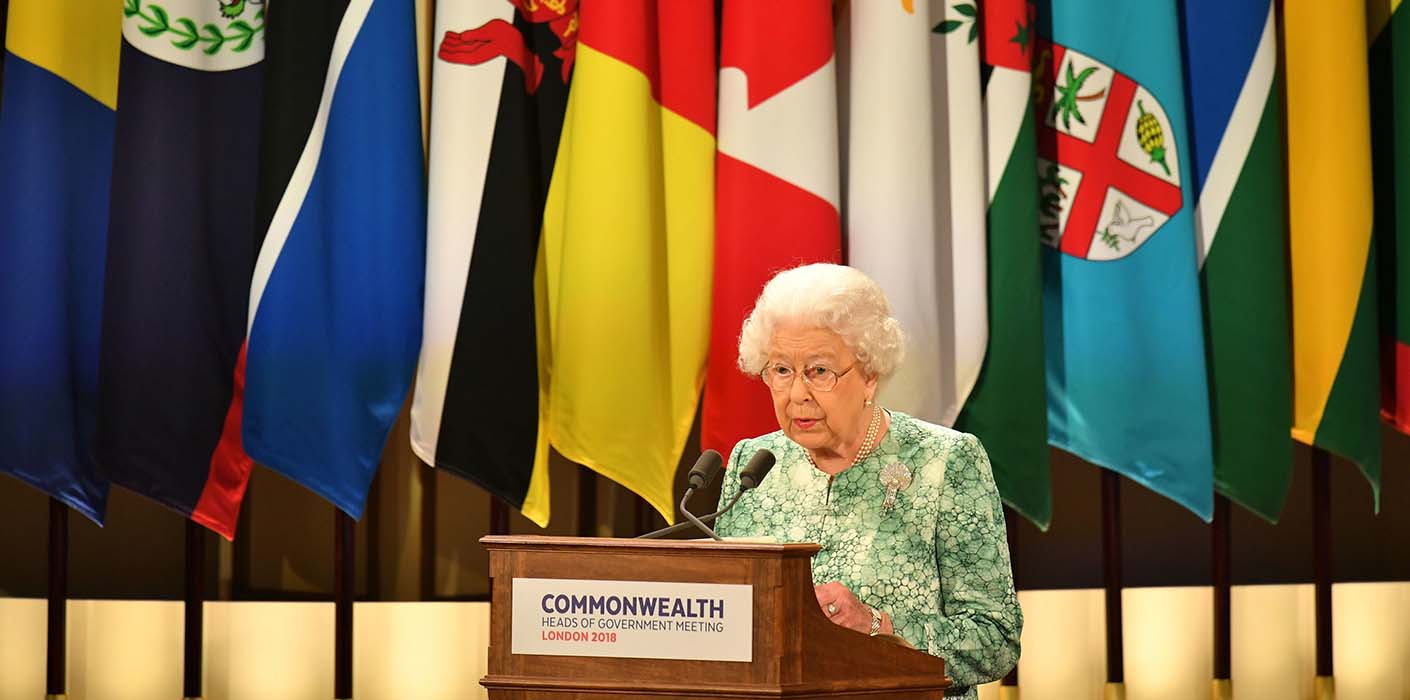
Queen Elizabeth II speaks at the formal opening of the Commonwealth Heads of Government Meeting in the ballroom at Buckingham Palace in London.
David Jessop View from Europe
The late Queen Elizabeth was widely revered for her sense of duty, her wisdom, advice, and the continuity she provided. As Head of the Commonwealth and as Britain’s monarch she represented selflessness and dedication rather than self-interest. She believed in the higher authority to whom she is now accountable. This and her ability to respond with great subtlety at critical moments at home and abroad meant that her real-world influence was significantly greater than most understand, and in a much-changed world unlikely to ever be seen again.
In 2018, Commonwealth Heads of Government accepted that as King, the then Prince of Wales, Charles, would succeed his mother as the head of what is now an organisation of fifty-six nations, the majority of which are Republics. Whether this arrangement will continue with his heir, or as some Commonwealth governments privately believe, see the role and duties rotate between Commonwealth nations, will emerge over time.
However, it will now be for Queen Elizabeth’s successor Charles III and perhaps more importantly his heir, Prince William, the new Prince of Wales, to adapt the role and find new ways to promote their vital endeavours relating to the environment, climate change, minorities, history, and the value of all faiths, in ways that re-educate and encourage change at home and in the Commonwealth.
An important element of this will be the way they present themselves in relation to the failure of many in Britain to understand their colonial history, and the unwillingness of some now in high political office to address rationally and publicly the issues and consequences, let alone accept that the Commonwealth is an association of equals.
In a recent editorial, The Guardian newspaper noted that while the monarchy has been involved in what it described as skirmishes with the government in relation to the Windrush scandal, deportations of undocumented migrants to Rwanda, and has acknowledged the legacy of slavery, it has not been able to change its post-imperial political delusion that the Commonwealth is an alternative to the European Union.
What has been striking in Britain in recent days, particularly in some parts of the media, has been the failure to comprehend that any decision to become a Republic, whether in the Caribbean or elsewhere in the Commonwealth, is a matter of sovereignty, and does not denote an end to a state’s continuing commitment to the Commonwealth or its Head.
Worse, it suggests that some in Britain still believe the country has some authority over nations that went to independence in some cases more than half a century ago. It is a view reflected in opinions previously expressed by some now senior figures in the British government who criticised Barbados’ decision to become a Republic on the basis that the island was in some way responding to a siren call from China.
That same incomprehension could again be seen on display following the passing of Queen Elizabeth in the media reaction to a comment made by Antigua’s Prime Minister, Gaston Browne, to ITV News about why the island was considering becoming a Republic. Unsurprisingly, he said it was the final step in becoming “a truly sovereign nation,” and was a matter for the people to decide and did not demonstrate any form of disrespect or hostility.
Subsequently, as my friend and fellow commentator Sir Ronald Sanders, Antigua’s Ambassador in Washington explained in a column, Caribbean nations wishing to become a Republic meant no disrespect to the Queen, or any diminution of their high regard for her worth, it “was simply a practicality.”
The two most senior members of Britain’s Royal Family understand this and have indicated that it is up to the governments and peoples of the Caribbean and elsewhere in the Commonwealth to decide who they want as head of state. There is also the sense that over time the ties that bind the Anglophone Caribbean to Britain and the monarchy may come to be shaped through a Commonwealth in which evolved relationships emerge.
Notably, when William, the now Prince of Wales, visited Belize, Jamaica, and The Bahamas earlier this year, he recognised that many in the Caribbean want a different relationship with Britain, and redress for past wrongs. During the visit he and his wife who are generationally different, worthy of respect, and live lives as near to normal as their status allows, made clear that their conversations in the Caribbean had “brought into even sharper focus questions about the past and the future.”
The “future is for the people to decide upon,” he said. “For us that’s not telling people what to do. It is about serving and supporting them in whatever way they think best, by using the platform we are lucky to have.” “Relationships evolve. Friendship endures.” He also accepted that “the appalling atrocity of slavery forever stains our history” and appeared to accept that he may not be elected head of the Commonwealth. His remarks were ground-breaking in that they suggested that the old order will not prevail forever.
In the Anglophone Caribbean its institutional arrangements and values remain close to those of Britain. There remain important ties through the diaspora, the overseas territories, co-ordination on many international issues, and for example real-time support on matters ranging from security to climatic disasters, but much else including trade and investment is diminished.
Quite rightly the Caribbean’s young people think little about Britain, other perhaps than as the former Imperial power.
This suggests that what may really matter far into the future is the reimagining of the Commonwealth as a free and equal association of nations that include Britain, as an organisation with a clear role, common purpose, and shared programmes wherever a commonality of interests exist. The likely decision by Australia in the coming years to become a Republic within the Commonwealth may help shape this.
There are indications that the new King and his heir may want to initiate a dialogue about the future with Commonwealth Government leaders, some of whom are privately sceptical about the organisation. In this they may be constrained by some in the new British government who are hostile to what they see as the liberal or ‘woke’ views held by the new monarch, fearing they might impede aspects of their political project, ‘Britannia Unchained.’
For these reasons, this should be the time when quietly, Caribbean Heads of Government, and where they remain, Governors General, should initiate with their counterparts across the Commonwealth a dialogue about what they hope for, and when it might be appropriate to launch such a conversation.
David Jessop is a consultant to the Caribbean Council Earlier columns can be found at https://www.caribbean-council.org/research-analysis/ [email protected] September 16th, 2022
The usual trash article from this author..Although it is true that political leaders in some Commonwealth countries are reviewing their status, the fact remains that whether a republic or not, countries prefer to be in the Commonwealth of nations rather than outside it .
bunch of disturbed pedophiles degenerates and self proclaimed “kings & queens”, barbarians ,who turned savages…killing millions for self glorification and benefits…Sapienti Sat
March 27, 2024 | 8:34 am
Psychiatrist’s warning: rising tendency towards suicide

March 26, 2024 | 9:06 am
CEMDOE presents innovative nursing training program

March 25, 2024 | 1:32 pm
Caribbean’s sargassum: a source of potential pharmaceuticals

March 21, 2024 | 10:48 am
Present the National Plan for Dengue: positive outlook

March 19, 2024 | 9:24 am
First Lady presents oncopediatric pavilion for child and adolescent care

March 19, 2024 | 8:16 am
First poison center established in the country

Bavaro & Punta Cana
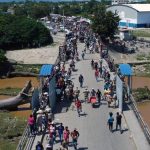
Business & Pleasure

North Coast

- ADVERTISING
- Privacy Policies
- Cookies Policy
DominicanToday.com - The Dominican Republic News Source in English
Av. Abraham Lincoln N° 452 Local 220B, Plaza La Francesa, Piantini, Santo Domingo
Tel. (809) 334-6386
- Today’s Paper
- Lok Sabha Polls
- Premium Stories
- Express Shorts
- Health & Wellness
- Board Exam Results
When the Queen came calling: Elizabeth’s three visits to India
During her reign she undertook three state visits to india, in 1961, 1983, and 1997. the queen and her royal consort, prince philip, the duke of edinburgh, first visited india in january 1961, the first royal british tour of india in 50 years..
Queen Elizabeth II, the head of state of the United Kingdom of Great Britain and Ireland, and Britain’s longest serving monarch died at the age of 96 on Thursday (September 8), after holding the throne for nearly 70 years.
After her father, King George VI died in 1952, Elizabeth ascended to the throne five years after India attained independence from colonial rule, becoming the first British ruler to take the throne after the empire lost its ‘jewel in the crown’. During her reign she undertook three state visits to India, in 1961, 1983, and 1997.

First visit: 1961
The Queen and her royal consort, Prince Philip, the Duke of Edinburgh, first visited India in January 1961, the first royal British tour of India in 50 years. According to newspapers cited by the BBC, people were so excited to catch a glimpse of her during the visit, that nearly a million people thronged the route that took her from the airport to the official residence of the President of India, Dr Rajendra Prasad, in New Delhi .
The royal couple toured Bombay ( Mumbai ), Madras ( Chennai ), and Calcutta ( Kolkata ), and also visited the Taj Mahal in Agra and the Pink Palace in Rajasthan. She paid tribute to Mahatma Gandhi at Raj Ghat in New Delhi.

President Dr Rajendra Prasad invited them as Guests of Honour for the Republic Day parade on January 26 of that year, and the Queen addressed thousands of people at a meeting in Delhi’s Ramlila Ground.
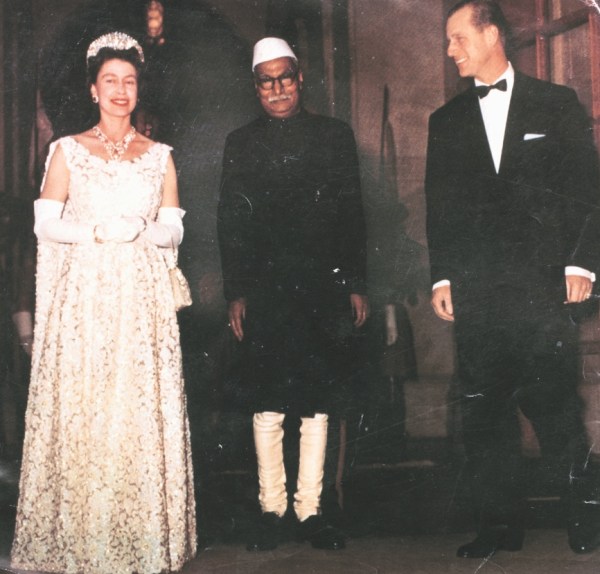
Second visit: 1983
Queen Elizabeth and Prince Philip’s next royal visit took place nearly two decades later, upon the invitation of President Giani Zail Singh, and they stayed at the visitors’ suite of the Rashtrapati Bhavan. According to a newspaper cited by the BBC, the Indian furnishings were replaced with Viceregal decor for the visit, and old Western style dishes were prepared for her, since the Queen was said to like “simple meals”.
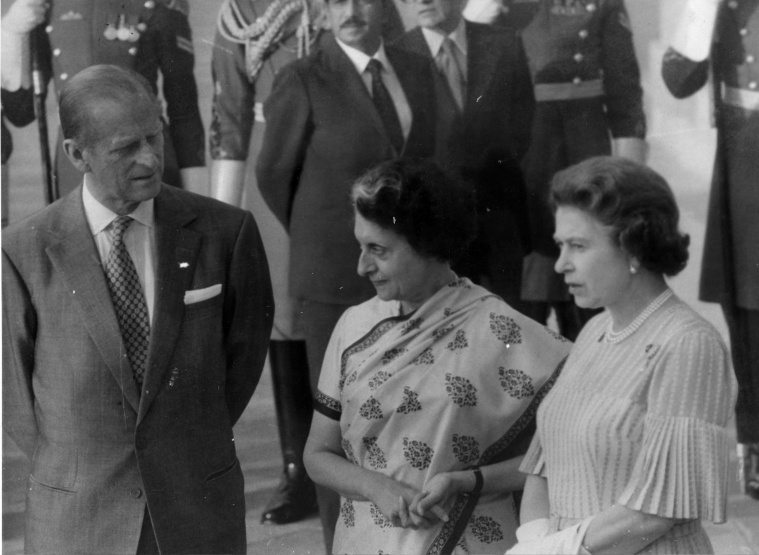
Her royal visit was at the same time as the Commonwealth Heads of Government Meeting (CHOGM) hosted by Prime Minister Indira Gandhi. During her visit, the Queen famously presented Mother Teresa — now Saint Teresa of Calcutta — with the honorary Order of Merit, an extremely exclusive reward that is only limited to 42 living members at one time, for her service to humanity.

Third visit: 1997
Her final and third royal visit to India in October 1997 was to mark the golden jubilee celebrations of India’s Independence. During her stay, Queen Elizabeth touched on the violence unleashed by British colonial rule in India. “It is no secret that there have been some difficult episodes in our past. Jallianwala Bagh is a distressing example,” she said in her banquet address.
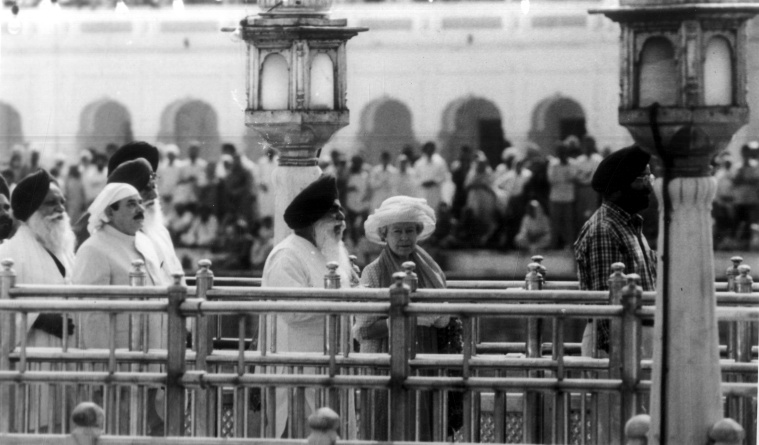
Amidst the calls for an apology for the killing of thousands of peaceful protesters upon the orders of General Reginald Dyer for protesting against the Rowlatt Act in 1919, Queen Elizabeth and Prince Philip visited Jallianwala Bagh in Amritsar and placed a wreath at the memorial.
- On Holi, a brief history of India’s love affair with bhang
- Pakistan may ‘seriously examine’ resuming trade with India: Why it paused, what it constituted
- Beyond Holi and bhang, the many uses of cannabis – from medicine to rope-making
While her speech and visit did not satisfy those who had called for an explicit apology, the BBC reported that it seemed to appease the relatives of those who were killed, who had planned a protest at the Amritsar airport during her arrival. The Queen was allowed to enter the Golden Temple after taking off her shoes
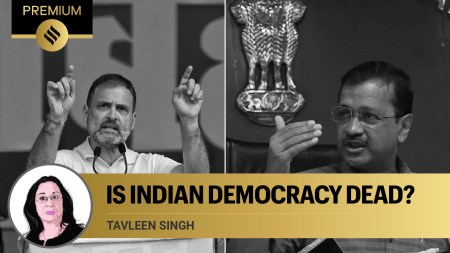
Is Indian democracy dead? Subscriber Only

UPSC Special: The Ultimate Package for Competitive Exam Preparation Sign In to read
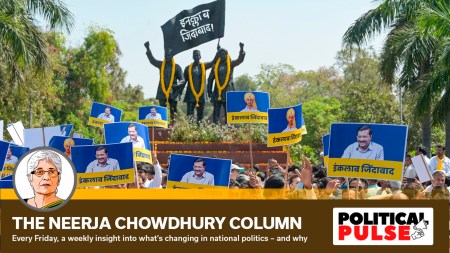
Kejriwal's arrest: Has BJP over-reached or is it a decisive Subscriber Only
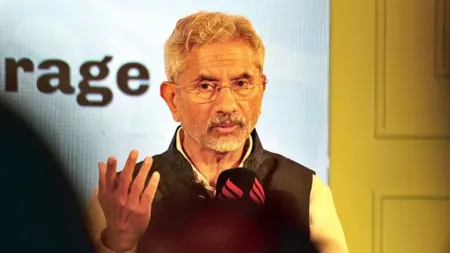
What Pakistan thinks of India’s democracy index

How confidentiality became a bad word Subscriber Only

The changing IIM: Over 2 decades, more and more women Subscriber Only
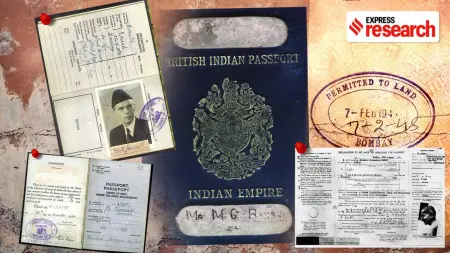
How citizenship was decided by makers of Indian Constitution Subscriber Only

How ads are becoming conversation starters Subscriber Only

Urvashi Kaur connects us to our roots Subscriber Only
- Express Explained
- Golden Temple
- Prince Philip
- Queen Elizabeth II
- Rashtrapati Bhavan
- Republic Day

ED raids the house of Punjab Excise and Taxation Commissioner Varun Roojam in Chandigarh following BJP's complaint to ECI. ED is also summoning excise department officials in Delhi for questioning. The raid puts pressure on the AAP government as its excise policy has been under the ED's scanner. This happens before the AAP's upcoming rally in Delhi.

More Explained


Best of Express
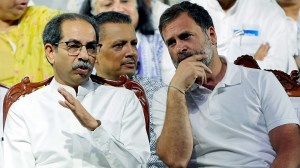
EXPRESS OPINION

Mar 27: Latest News
- 01 NDA officer loses Rs 57 lakh in online share trading scam
- 02 Bar on political activities as bail condition violative of rights, SC tells Orissa HC
- 03 AAP MLAs among 260 detained as police stop march to PM home
- 04 280 booked for drunk driving during Holi
- 05 Who was Francis Scott Key, whose namesake bridge fell? His poem became ‘The Star-Spangled Banner’
- Elections 2024
- Political Pulse
- Entertainment
- Movie Review
- Newsletters
- Web Stories
Tracing Queen Elizabeth’s steps through the U.S.
By Danielle Paquette | Sep 10, 2022
During her seven-decade reign, Queen Elizabeth II visited more than two dozen cities across the United States. She chatted with Girl Scouts, football players, presidents and Frank Sinatra . She cheered on race horses in Kentucky. She requested a ham sandwich with the crust removed in Texas. She sported a tweed skirt-suit in Yosemite National Park.
Wherever England’s longest-serving monarch went, photographers followed, capturing generations of Americans in the throes of Royal fever (and more than a few signature handbags ).
Oct. 17, 1957 | Washington
Queen Elizabeth II heads to the White House as crowd's line Washington streets to see the royal monarch.
Oct. 18, 1957 | Washington
Queen Elizabeth II accepts a doll for Princess Anne from 7-year-old Pamela Springmann during a visit at Children's Hospital.
Queen Elizabeth II and Vice President Richard Nixon tilt their heads for a better view of the oil paintings on the interior of the Capitol dome during a tour.
Oct. 19, 1957 | College Park, Md.
Co-captains of North Carolina and Maryland meet Queen Elizabeth II before the start of a game.
Oct. 21, 1957 | New York
Queen Elizabeth II, wearing a mink stole, and Prince Philip, standing next to a viewing telescope, view New York City from the observatory roof of the Empire State Building. The Queen said, "It's the most beautiful thing I've ever seen."
Queen Elizabeth II, in a plastic domed car, rides up lower Broadway through a shower of ticker tape and confetti during procession to City Hall.
Queen Elizabeth II addresses the United Nations General Assembly.
Her Majesty kicked off a seven-city tour of the nation’s east in 1976 with a stop in Philadelphia, where she unveiled a gift for the City of Brotherly Love: a Bicentennial Bell to celebrate 200 years of American independence from English rule. (The bell remains in storage .)
July 7, 1976 | Andrews Air Force Base, Md.
Queen Elizabeth II and Prince Philip walk down the ramp of their aircraft near Washington.
July 7, 1976 | Philadelphia
Queen Elizabeth II is greeted by the Girl Scouts of America.
July 8, 1976 | Washington
Queen Elizabeth II arrives at the U.S. Capitol.
On her New York leg, Elizabeth was spotted squeezing through city throngs, underscoring the lighter security protocols of yesteryear.
July 10, 1976 | New York
Thousands surround Queen Elizabeth II as she walks from the Federal Building up Wall Street to Trinity Church with Mayor Abraham Beame.
J Walter Green
July 10, 1976 | Charlottesville, Va.
Queen Elizabeth II tours Thomas Jefferson's Monticello home.
July 11, 1976 | Boston
Queen Elizabeth II and Prince Philip wave to spectators below from the balcony of the Old State House before the Queen descended to street level to address the crowd. The location is the site of the Boston massacre, an event which led to the Revolutionary War.
Elizabeth returned in 1983 for a trek through the West Coast. She visited a Southern California retirement home, led a champagne toast with then-president Ronald Reagan and absorbed the mountain views at Yosemite National Park.
Feb. 26, 1983 | San Diego
Queen Elizabeth II reviews the U.S. Marine Corps honor guard as she arrives for a State visit.
Feb. 28, 1983 | Sierra Madre
Queen Elizabeth II shares a smile with 97-year-old Sibyl Jones-Bateman after the monarch was presented with a bouquet during tour of the British Home retirement community near Los Angeles.
March 3, 1983 | San Francisco
President Ronald Reagan and Queen Elizabeth II raise their glasses in a toast during a state dinner at the M. H. de Young Museum in Golden Gate Park.
Ed Reinke/AP
March 5, 1983 | Yosemite, Calif.
Park superintendent Bob Binnewies points out highlights from Inspiration Point to Queen Elizabeth II during her visit to Yosemite National Park.
The queen, a horse racing enthusiast, landed in Kentucky five times between 1984 and 2007, according to the Courier-Journal . She was known to turn up at horse farms, admiring the mares and foals.
May 23, 1986 | Versailles, Ky.
Queen Elizabeth II puts out her hand to her filly foal by the mare Christchurch and Alydar during a visit to Lane's End Farm.
May 27, 1986 | Lexington, Ky.
Queen Elizabeth II exchanges pleasantries with a line of Fayette County (Ky.) and Kentucky State Troopers on the tarmac as prepares to depart following a five-day visit.
Amy Sancetta/Associated Press
May 26, 1989 | Lexington, Ky.
Queen Elizabeth II is welcomed by a child upon her arrival during a private visit to the U.S.
David Banks
During her 1991 visit, Elizabeth addressed Congress. Lawmakers gave the monarch a standing ovation, while opponents of British occupation in Northern Ireland protested outside the Capitol.
May 14, 1991 | Washington
Queen Elizabeth II and President George H.W. Bush review the troops after the Queen's arrival at the White House.
May 15, 1991 | Washington
Queen Elizabeth II holds flowers presented to her at Drake Place, a housing project.
May 16, 1991 | Washington
Queen Elizabeth II is applauded by Vice President Dan Quayle and House Speaker Thomas Foley before her address to the U.S. Congress.
Doug Mills/AP
Elizabeth’s last U.S. state visit came in 2007, when she arrived for the 400th anniversary of England establishing its first permanent North American settlement in Jamestown, Va.
She dined with then-president George W. Bush, watched the Kentucky Derby through bulletproof glass and checked out Washington memorials.
May 4, 2007 | Lexington, Ky.
Queen Elizabeth II and Prince Philip look out of the window of an SUV as they leave the Bluegrass Airport after arriving.
Morry Gash/AP
May 5, 2007 | Louisville, Ky.
Queen Elizabeth II chats with Prince Philip as Susan Lucci (black hat) looks on at the 133rd Kentucky Derby at Churchill Downs.
Rob Carr/AP
May 7, 2007, | Washington
President Bush smiles at Queen Elizabeth II before the start of a State Dinner at the White House.
Evan Vucci/AP
May 8, 2007 | Washington
Queen Elizabeth II and U.S. Park Service Director Mary Bomar walk around the National World War II Memorial during a visit by the Queen and Duke.
TIMOTHY A. CLARY/AFP via Getty Images
May 8, 2007 | Greenbelt, Md.
Queen Elizabeth II accepts flowers from children while walking during a visit to the Goddard Space Flight Center.
Larry Downing
Elizabeth made her final stop on American soil in 2010 to address the United Nations General Assembly. “I believe I was last here in 1957,” she deadpanned to her New York audience.
July 6, 2010 | New York
Queen Elizabeth II leaves a wreath of flowers at the site of the September 11, 2001 World Trade Center attack during her visit.
Lucas Jackson
Queen Elizabeth II speaks at the United Nations Headquarters.
Seth Wenig/AP
More from the Post
Photos: The life of Queen Elizabeth II, Britain’s longest-reigning monarch
The queen’s travels, in photos
The latest from The Washington Post
Photo editing and production by Natalia Jiménez
- Remote Work
- Ontario Budget
- Baltimore Bridge Collapse
- Local Change location
- Entertainment
- Perspectives
TV Programs
- Global National
- The Morning Show
- Video Centre
- More…
- Email alerts
- Breaking News Alerts from Global News
- License Content
- New Brunswick
- Peterborough
Close Local
Your local region.
- All event types
Quick Search
Trending now.
Add Global News to Home Screen Close
Instructions:
- Press the share icon on your browser
- Select Add to Home Screen
Comments Close comments menu
Want to discuss? Please read our Commenting Policy first.
Queen Elizabeth visited B.C. 7 times, the first time as a princess in 1951

If you get Global News from Instagram or Facebook - that will be changing. Find out how you can still connect with us .
Queen Elizabeth II , whose death was announced on Thursday at the age of 96, visited the province of British Columbia seven times in her life.

She first visited in 1951 as Princess Elizabeth, Duchess of Edinburgh, and Prince Philip, Duke of Edinburgh. The couple arrived in Vancouver by train, visited Victoria and Nanaimo, and enjoyed a private retreat in Qualicum Beach.
The last time she came to B.C. was in October 2002 as part of a visit to Nunavut. She also went to Manitoba, Ontario and New Brunswick during a tour to celebrate her Golden Jubilee.
The Queen and Prince Phillip also visited Victoria, where she unveiled a stained-glass window in the B.C. Parliament Buildings and dropped the puck at a NHL exhibition game in Vancouver.
The National Hockey League mourns the passing and celebrates the remarkable life of Queen Elizabeth II. She held a special place in the hearts of Canadians and, during her 70-year-reign, connected with our game in memorable ways. pic.twitter.com/ppgk5HZzFQ — NHL (@NHL) September 8, 2022
In August 1994, Queen Elizabeth and Prince Philip opened the Commonwealth Games in Victoria and had a private retreat at Twin Island.
She also visited CFB Comox and Prince George, while Philip went to Prince Rupert and the Khutzeymateen Valley.
The couple also visited B.C. in October 1987 when they spent time privately in Qualicum Beach before going to Vancouver and Greater Victoria, attending the Commonwealth Heads of Government meeting. During this visit, Queen Elizabeth II unveiled B.C.’s new Coat of Arms .
In March 1983, they again visited Victoria on the Royal Yacht Britannia.
Other stops included Vancouver, Nanaimo, Vernon and New Westminster. The Duke of Edinburgh visited Kamloops on his own.
In May 1971, the royal couple and their daughter, Princess Anne, visited B.C. on the Royal Yacht Britannia to mark the centenary of B.C.’s entry into confederation. Stops included Vancouver, Victoria, Nanaimo, Comox, Penticton, Kelowna, Vernon, Prince Rupert and Williams Lake.
Princess Anne visited Tofino by herself.
A statement from His Majesty The King: pic.twitter.com/AnBiyZCher — The Royal Family (@RoyalFamily) September 8, 2022
In June 1959, the two visited several cities on their journey through B.C. on the royal train. Stops included Golden, Revelstoke, Kamloops, Spences Bridge, New Westminster, Vancouver, Victoria and Nanaimo.

Sponsored content
Report an error, subscribe here.

16 visits over 57 years: reflecting on Queen Elizabeth II’s long relationship with Australia
Associate Professor of English, Flinders University
Disclosure statement
Giselle Bastin does not work for, consult, own shares in or receive funding from any company or organisation that would benefit from this article, and has disclosed no relevant affiliations beyond their academic appointment.
Flinders University provides funding as a member of The Conversation AU.
View all partners
“Elizabeth the Second, by the Grace of God Queen of Australia and Her other Realms and Territories, Head of the Commonwealth” has died. Given her advanced years, this has long been expected, yet it still seems incredible this woman who has been Australia’s queen for the duration of most Australians’ lives is no longer with us.
While the focus of the formalities and ceremony of the passing of Queen Elizabeth II will centre on London and the UK, there is no doubt it will be keenly observed by many Australians.
The queen liked Australia and Australians. She came here 16 times throughout her reign and was, famously, on her way to our shores in 1952 when she learned her father had passed on and she was now queen.
Her visits to Australia – from her first in 1954 through to her last in 2011 – offer a snapshot of the changing relationship Australians have had with their sovereign and with the monarchy.
An enthusiastic nation
The queen’s 1954 tour took place during a time described by historian Ben Pimlott as the age of “ British Shintoism ”. Deference to the Crown was paramount in Britain and the Commonwealth, and many Australians were madly enthusiastic about their queen.

After her arrival at Farm Cove in Sydney on February 3 1954, Elizabeth II became the first British monarch to set foot on Australian soil. The royal tour lasted nearly two months and consisted of a gruelling schedule taking in visits to every state and territory apart from the Northern Territory.
During the tour, the queen greeted over 70,000 ex-service men and women; drove in cavalcades that took in massive crowds; attended numerous civic receptions; and opened the Australian Parliament in Canberra. The tour saw Elizabeth travel 10,000 miles by air and 2,000 miles by road – including 207 trips by car and by appointed royal trains.
It is estimated as much as 75% of the population saw the queen and Prince Philip during this tour.
No Australian prime minister has ever had a reception on this scale or exposure to so many of the country’s citizens.
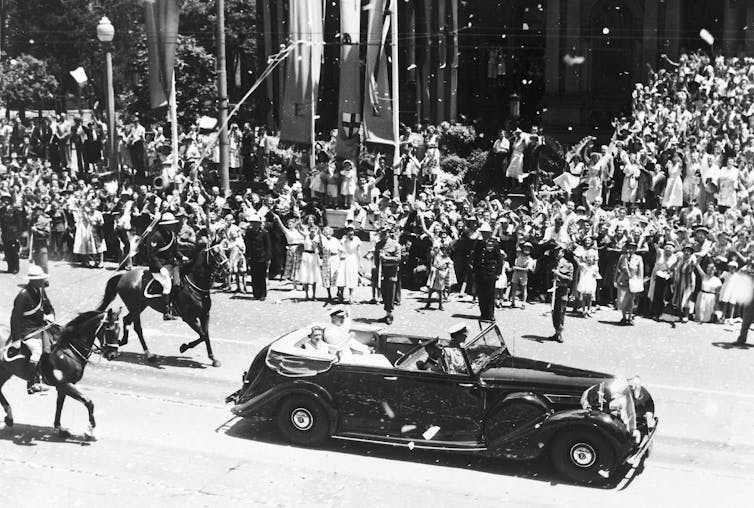
A “new” and prosperous country
During her first two tours in 1954 and 1963, the Australia laid-out for display for the queen was depicted as having gone from being a small colonial settlement to a thriving economy that had ridden to prosperity “ on the sheep’s back ”.
The queen was treated to endless displays of sheep shearing, surf carnivals, wood chopping, whip cracking, and mass displays of dancing and singing by school children. Federal and state dignitaries, mayors and civic leaders from across the political divide jostled to meet and be seen with her; the country’s florists were emptied of flowers for the hundreds of bouquets presented to her by dozens of shy, nervous school children nudged gently forward by awe-struck parents.
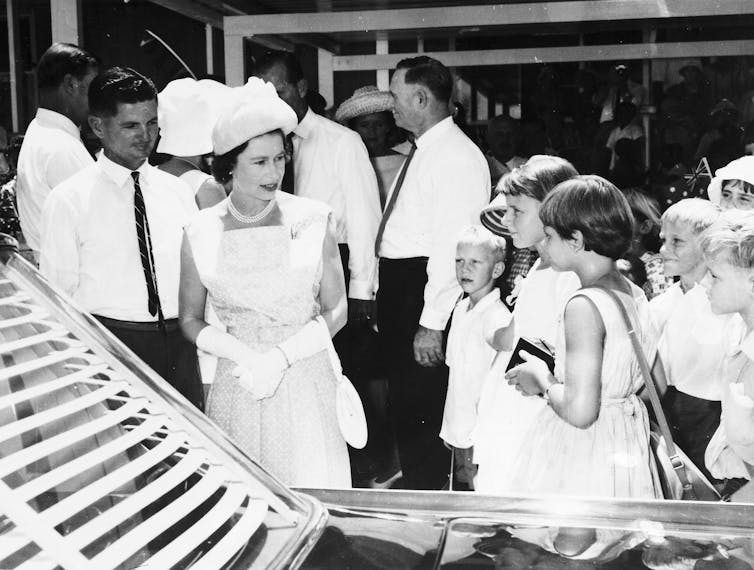
During the early tours, Aboriginal Australians were kept at a discreet distance. Apart from a demonstration of boomerang and spear throwing, the closest the queen came to experiencing anything of Indigenous Australian culture was a ballet performed by the Arts Council Ballet titled Corroboree, with no Aboriginal dancers but dancers with blackened faces.
During the 1970 visit, the queen witnessed the re-enactment of Captain James Cook’s arrival at Botany Bay, with Cook and his crew meeting “the resistance of the Aborigines with a volley of musket fire”.
By 1973, Indigenous Australians were given a more significant role in the royal tours. Aboriginal actor Ben Blakeney, one of Bennelong’s descendants, gave the official welcome during the opening of the Sydney Opera House, and the then unknown actor David Gulpilil was among those performing a ceremonial dance.
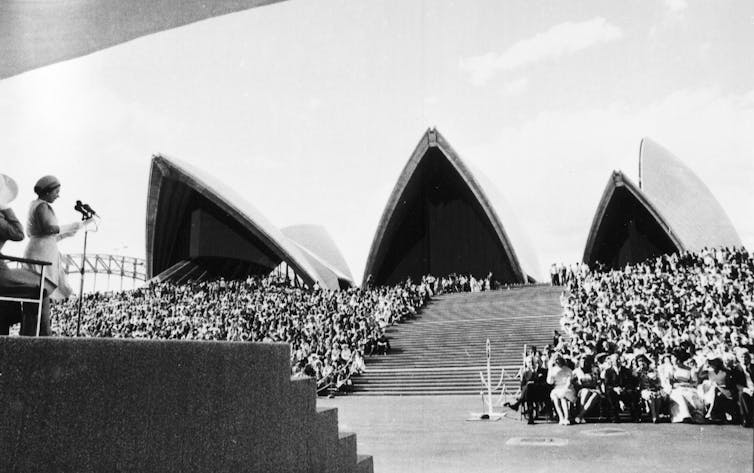
Invited guest, not ruler of the land
As early as the 1963 tour, the nation-wide royal fervour had dimmed a little. The 1963 visit witnessed smaller crowds and fewer mass public events. When Prime Minister Robert Menzies courted the queen with the now-famous line, “I did but see her passing by, and yet I love her till I die”, the ensuing blushes – including the queen’s own – reflected many Australians’ growing sense of embarrassment at public displays and unquestioning expressions of deference.
Despite this, Menzies’ displays of public ardour saw him being granted The Order of the Thistle shortly after, a bestowal which must surely remain the envy of some subsequent prime ministers.
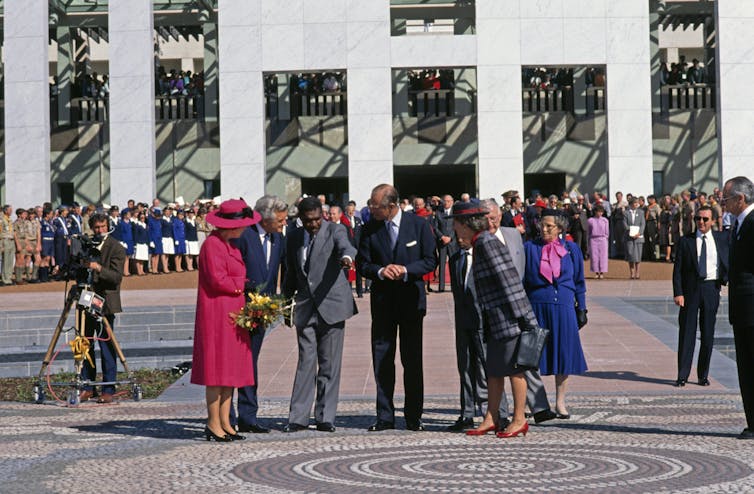
The 1977 Silver Jubilee and 1988 Australian bicentenary visits perhaps marked the end of a period of royal tours as overt celebrations of Australia’s ties to Britain. This new flavour of tours positioned the sovereign as an invited guest to an independent, modern and multi-cultural nation.
On her 10th tour in 1986, the queen returned to sign the Australia Act , which brought to an end the ability of the UK to create laws for Australia.
Her role as our sovereign subtly transformed from cutting ribbons and opening Parliament to signing the documents that slowly, by degrees, contributed to the cutting of Australia’s ties to the UK and the Crown.
A question of the republic
By the 12th tour in 1992, the cost of the queen’s visits to Australia were increasingly scrutinised by a public feeling largely indifferent about the royal family. The prime minister of the day, Paul Keating, was seen not so much as an entranced liege lord revelling in the opportunity to see his sovereign “passing by” as one who instead – unthinkingly – committed an act of lèse majesté by placing his bare hand on the royal back and waist as he guided her through the crowd.
The gloves, it seemed, were coming off.
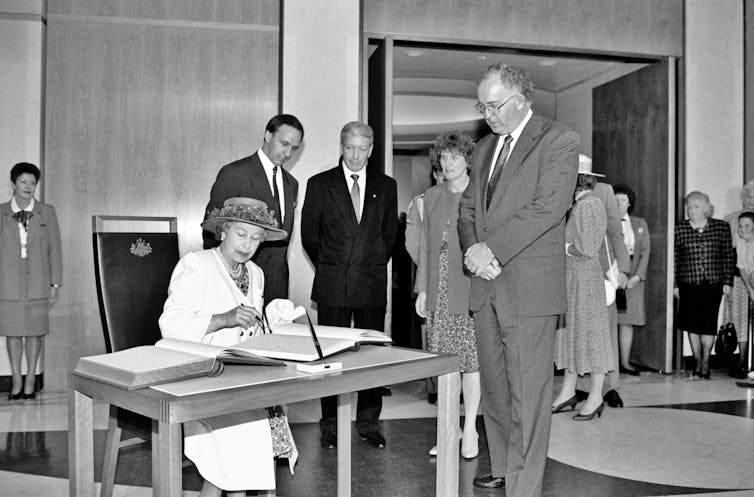
The queen made it clear in her last visits to our shores that whether or not Australia should become a republic was a decision for its own citizens to make. Her official announcement after she learned of the result of the 1999 Republic Referendum confirmed this:
I have always made it clear that the future of the Monarchy in Australia is an issue for the Australian people and them alone to decide, by democratic and constitutional means. … My family and I would, of course, have retained our deep affection for Australia and Australians everywhere, whatever the outcome.
In the last decades of her life, the queen retained the affection of many. Her popularity seemed to grow in line with Australians’ increased disenchantment with their home-grown political leaders: the former prime ministers Malcolm Turnbull and Julia Gillard are right to have sensed that any discussion about an Australian republic would have to wait until after Elizabeth II’s death.
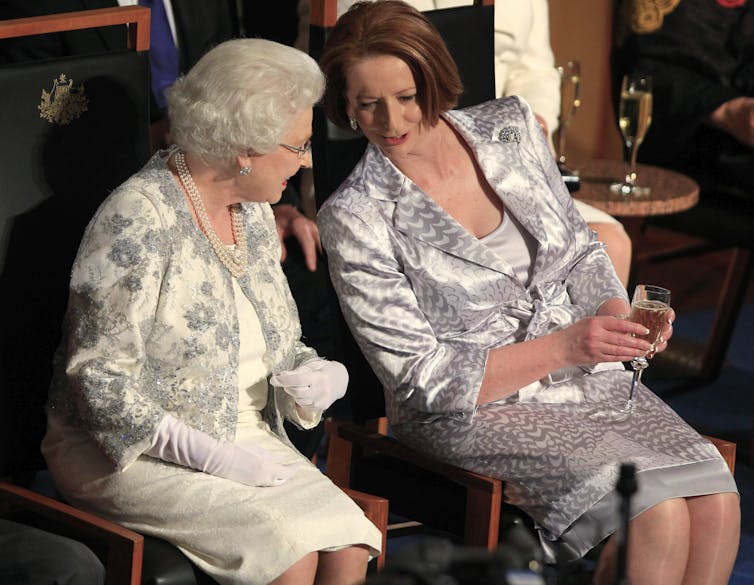
Queen Elizabeth II reigned across seven decades and her tours to Australia served as a marker of Australia’s changing relationship with the Crown as well as with its own colonial past and national identity.
Almost certainly, Elizabeth II’s reign as the stalwart, loyal, dutiful, and most cherished and admired of “Glorianas” is one we are unlikely ever to see again.
Correction: the article previously stated the queen was on her way to Australia in 1953 when she learned of her father’s death. This has been corrected to 1952.
- Queen Elizabeth II
- Australian Republic Movement

Research Fellow in Tropical Climate Variability

Director, Defence and Security

Opportunities with the new CIEHF

School of Social Sciences – Public Policy and International Relations opportunities

Deputy Editor - Technology
SUPPORT OUR JOURNALISM: Please consider donating to keep our website running and free for all - thank you!
- Meet the team
- Privacy Policy
- Royal Weddings
- Media & Commentary requests

Forty Years: The Historic State Visit of The Queen to the Vatican
Forty years ago, on 17 October 1980, Queen Elizabeth II made history as she became the first British Monarch to make a state visit to the Vatican. The visit was seen as a chance to forge relations between the Church of England and the Roman Catholic Church.
The Queen, who was accompanied by her husband the Duke of Edinburgh, dressed in a long black taffeta gown in line with Vatican protocol. The Pope welcomed Her Majesty and the Duke for what was described as a “warm and relaxed visit.”
Trumpets sounded and the royal procession moved slowly along the corridor into the Clementine Hall. The Queen and the Duke were then welcomed by John Paul II at the door of his private library. Following her meeting, the Queen opened her speech with assurances of good will and sincere friendship.
Private talks followed during the Queen’s visit. She was presented with a facsimile of the manuscript of Dante’s Divine Comedy with its illustration of the Order of the Garter in the time of Edward IV. In return, the Queen gave the Pope a book about Windsor Castle by St John Hope and two signed photographs.
Following the private conversation, the Queen and the Duke met with the Pope’s Secretary of State, Cardinal Casaroli, at the home of the British Minister to the Holy See, Mark Heath.
Two years later, the Queen would invite the Pope to England but it was made clear it would not be a State Visit but, a visit “to the Roman Catholic community in Great Britain where some four million of my people are members of the Roman Catholic Church.”
“We support the growing movement of unity between the Christian Churches throughout the world and we pray that your Holiness’s visit to Britain may enable us all to see more clearly those truths which both unite and divide us in a new and constructive light.”
In response, the Pope welcomed the opportunity saying:
“I render homage to the Christian history of your people, as well as to their cultural achievements. The ideals of freedom and democracy, anchored in your past, remain challenges for every generation of upright citizens in your land.”
In the years following, Pope John Paul II and the Queen would continue to build their friendship. In 1982, the Pope made a historic visit to Buckingham Palace and, in 2000, the Queen returned to the Vatican to mark the 20th anniversary of their first meeting.
The Pope said of their relationship: “Relations between the United Kingdom and the Holy See have not always been untroubled; long years of common inheritance were followed by the sad years of division. But in recent years there has emerged between us a cordiality more in keeping with the harmony of earlier times and more genuinely expressive of our common spiritual roots.”
Pope John Paul II died on Saturday 2 April 2005 after he failed to recover from a throat operation. The Prince of Wales attended his funeral after postponing his wedding to the Duchess of Cornwall by 24 hours to attend.
Share this:
About author
Sydney zatz, latest posts, queen camilla says princess of wales will be ''thrilled'' with get well soon wishes, king harald seen for first time since surgery as he begins easter break, the little prince who is marking a big milestone, jamaica's governor general praises princess of wales for 'exemplary strength and selflessness', never miss the latest, most popular, the queen watches on with pride as lady louise drives prince philip’s carriages at windsor horse show, an annus horribilis in monaco a difficult year for albert and charlene finally winds to an end, the duchess of cambridge wows tv audiences with a musical piano performance on christmas eve, latest blogs, the royals who brought romance to an historic evening with their wedding tiaras.
The great queen written out of history: Katherine Parr
A royal rarity - an emerald engagement ring
The princess of wales makes her children her priority as she undergoes treatment for cancer, the strength and dignity of the princess of wales is an example to us all.

IMAGES
COMMENTS
Presentation of a book of the Six Decades of H.M.The Queen's Commonwealth and State Visits, 18 December 2012. Queen Elizabeth II undertook a number of state and official visits over her 70-year reign (1952 to 2022), as well as trips throughout the Commonwealth, making her the most widely travelled head of state in history.She did not require a British passport for travelling overseas, as all ...
After ascending to the thrones of the Commonwealth realms in 1952, Queen Elizabeth II received a total of 112 state visits. She usually hosted one or two visiting heads of state each year. According to the palace, any visit that does not include a state banquet held by the Queen is not considered a state visit.
Here is a full list of all the countries and states the Queen travelled to during her reign, and the dates when she visited. Algeria (1980) Antigua and Barbuda (1966, 1977, 1985) Australia (1953 ...
Having met President Harry S. Truman in Washington in 1951 during a visit before ascending to the throne, Elizabeth was no stranger to America when she arrived on her first trip as Queen.
Queen Elizabeth II did not make any state visits to about 60 countries - which are not mentioned in the list of nations that she visited once. ... In Europe: Austria, Czech Republic, Estonia ...
Presentation of a book of the Six Decades of H.M.The Queen's Commonwealth and State Visits, 18 December 2012. Queen Elizabeth II became Head of the Commonwealth upon the death of her father, King George VI, on 6 February 1952 and remained Head of the Commonwealth until her death on 8 September 2022.During that time, she toured the Commonwealth of Nations widely.
Historic visits were also made closer to home in 2011 when the Queen became the first British monarch in a century to visit the Republic of Ireland, cementing the 1998 Good Friday agreement ...
A royal progress took a lot of preparation, however, and the Queen's ministers, courtiers, and servants did not share her enthusiasm for them. In fact, all the work involved, and all the dangers public travel constituted for the Queen, caused them a lot of headaches! But the work was worth it as the progresses were always a great success.
The Queen carried out a number of historic trips, including becoming the first British monarch to visit China in 1986, and the first in a century to tour the Republic of Ireland in 2011, but there are still places she never visited, including Israel, thought to be due to political reasons, and Greece, because of Prince Philip's family history in the country.
The island nation, a democracy of about 300,000 people, announced in September that it would remove Queen Elizabeth as head of state, the latest Caribbean nation to do so. It joined Guyana, which ...
The Commonwealth and the monarchy. Queen Elizabeth II speaks at the formal opening of the Commonwealth Heads of Government Meeting in the ballroom at Buckingham Palace in London. The late Queen Elizabeth was widely revered for her sense of duty, her wisdom, advice, and the continuity she provided. As Head of the Commonwealth and as Britain's ...
Queen Elizabeth II, the head of state of the United Kingdom of Great Britain and Ireland, and Britain's longest serving monarch died at the age of 96 on Thursday (September 8), after holding the throne for nearly 70 years.. After her father, King George VI died in 1952, Elizabeth ascended to the throne five years after India attained independence from colonial rule, becoming the first ...
Queen Elizabeth II leaves a wreath of flowers at the site of the September 11, 2001 World Trade Center attack during her visit. Lucas Jackson July 6, 2010 | New York
Elizabeth II (born April 21, 1926, London, England—died September 8, 2022, Balmoral Castle, Aberdeenshire, Scotland) was the queen of the United Kingdom of Great Britain and Northern Ireland from February 6, 1952, to September 8, 2022. In 2015 she surpassed Victoria to become the longest-reigning monarch in British history.
Barbados has officially removed Queen Elizabeth II as its head of state and become the world's newest republic. In an overnight ceremony in the capital, Bridgetown, Dame Sandra Mason was sworn in ...
During this visit, Queen Elizabeth II unveiled B.C.'s new ... Ontario woman forced to walk topless through airport security in Dominican Republic. View image in full screen. Queen Elizabeth ...
Queen Elizabeth II signed the proclamation in Ottawa on April 17, 1982. Queen Elizabeth II signs Canada's constitutional proclamation as Prime Minister Pierre Trudeau looks on, in Ottawa, April 17 ...
During her seven visits to Toronto, Queen Elizabeth did plenty of marvelling: at gleaming municipal buildings, suburban malls, grape-stomping exhibitions. "She really wanted to know what makes ...
Queen Elizabeth II reads the Throne Speech in the Senate Chambers Oct. 18, 1977, officially opening the session of Parliament. Prime Minister Trudeau sits to the right of the Queen.
The queen liked Australia and Australians. She came here 16 times throughout her reign and was, famously, on her way to our shores in 1952 when she learned her father had passed on and she was now ...
Queen Elizabeth II of the United Kingdom of Great Britain and Northern Ireland and her husband Prince Philip made a state visit to the Republic of Ireland from 17 to 20 May 2011, at the invitation of the President of Ireland, Mary McAleese.It was the first visit by a reigning British monarch to the area that is now the Republic of Ireland since the 1911 tour by Elizabeth's grandfather King ...
Queen Elizabeth shares a laugh with then-premier Ernie Eves during her visit to Toronto in 2002. On Wednesday, Queen Elizabeth II will have been the United Kingdom's monarch for 63 years, seven ...
17th October 2020. Forty years ago, on 17 October 1980, Queen Elizabeth II made history as she became the first British Monarch to make a state visit to the Vatican. The visit was seen as a chance ...